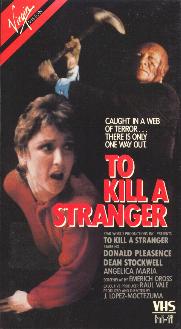
(Angel Films-Radio Video Prods.-Star World Prods., 1982)** Prod: Raúl Vale; Dir: Juan López Moctezuma; Scr: Emerich Oross; Scr Revisions: Rafael Buñuel, Michael Elliot, Juan López Moctezuma, Morrie Ruvinsky; Photo: Alex Phillips; Music: Mort Garson; Prod Mgr: Jaime Alfaro; Prod Coord: Federico Serrano; Asst Dir: Arturo García Rubio; Film Ed: Carlos Savage; Decor: Salvador Lozano, Carlos Granjean; Post-Prod Supv: Paul Leder; Sound Mixer: Roberto Camacho
*[this film is also known as Secuestrada (Kidnaped) and may also have been called Trampa Nocturna; the Mexican lobby cards were released with the title Para matar a un extraño but in some cases the "para" was marked out (see example below).]
**[the film was shot from Oct-Dec 1982; it was released in Mexico in 1986]
CAST: Angélica María (Cristina Carver), Dean Stockwell
(John Carver), Donald Pleasance (Col. Kostik), Aldo Ray (Insp. Benedict),
Sergio Aragonés (Major Keller), Jill Franklyn (Susan), Juan
José Gurrola (truck driver), Ken Grant (Tom), Rick Sharp
(Benedict's ass't.), José Angel Espinosa (gas station attendant),
Juan López Moctezuma (Albert Morell), Arturo García Rubio
(sound ass't.), Joffrey de la Fontaine (hotel mgr), Martin Lassalle
(Sgt.), Susana Kamini (Esbietha), Yolanda Ortiz (woman), Thomas Stoehr
(camera operator), Salomón Laiter? (older man at airport)

NOTES: Secuestrada (which is the Spanish-language version's TV title and the one I have seen) features a number of performers who have worked with López Moctezuma before, including Juan José Gurrola (who appeared in El Topo), Martin Lassalle (or LaSalle), José Angel Espinosa, and Susana Kamini. (An in-joke: an older Jewish man is arrested at an airport in Secuestrada; he gives his name as "Salomón Laiter." This may actually be Laiter, another independent filmmaker from the 1970s). López Moctezuma appears in the pre-credits sequence of this film, as a journalist who is murdered by soldiers. Sergio Aragonés is best-known as a cartoonist for Mad magazine.
Singer Cristina flies to an unnamed European country to join her
journalist husband John. He cannot meet her at the airport, so she rents
a car to drive to the city. On the way, she swerves off the road to avoid
hitting a bicyclist, and her car is disabled. A well-dressed man offers
her a ride. When they get to his house, the man at first seems pleasant,
but then begins to heap verbal abuse on Cristina, finally attempting to
kill her. She shoots him with his own shotgun. Cristina manages to hail
a passing truck; the driver comes back to the house with her, and
 identifies the dead man as Colonel Kostik, a national hero and a powerful
figure in the military government. The driver flees, leaving Cristina
alone with the body. Realizing her story will not be believed, Cristina
tries to cover her tracks; first she puts Kostik's body in a sack and
lowers it into a well, then retrieves it and buries it in a wooded area.
The next morning, she joins her husband.
identifies the dead man as Colonel Kostik, a national hero and a powerful
figure in the military government. The driver flees, leaving Cristina
alone with the body. Realizing her story will not be believed, Cristina
tries to cover her tracks; first she puts Kostik's body in a sack and
lowers it into a well, then retrieves it and buries it in a wooded area.
The next morning, she joins her husband.
Kostik is missed, and foul play is suspected. Police inspector Benedict believes Cristina may have been involved. The truck driver is arrested, but dies while being questioned. He claims that a woman was behind Kostik's murder. Cristina tells John what happened; she can't leave the country because her passport has been confiscated. They decide to hide Kostik's body more thoroughly, but are caught by Major Keller of the army while exhuming it. He intends to execute them on the spot, but Benedict arrives. The body in the sack is not Kostik, but the decomposed corpse of a woman! The well is examined, and 3 more women's bodies turn up, along with Kostik's (Cristina had fished out the wrong sack). Kostik was actually a mad killer preying on foreign tourists, so Cristina is cleared of the murder charge.
Secuestrada is well-produced and acted, but it never develops
 the kind of tension and suspense that would lift it above the norm. Some
of the sequences seem to drag on much longer than they should (such as the
scene in which Pleasance tries to strangle Angélica María,
which goes on forever, as she struggles, gasps and gags). The
performances are also generally good. Stockwell, Pleasance, and Ray at
least were dubbed in the Spanish-language version I saw, presumably the
original (English) version has them doing their own dialogue;
Angélica María sings the theme song in English, and I guess
she did her own dialogue in the original version as well.
the kind of tension and suspense that would lift it above the norm. Some
of the sequences seem to drag on much longer than they should (such as the
scene in which Pleasance tries to strangle Angélica María,
which goes on forever, as she struggles, gasps and gags). The
performances are also generally good. Stockwell, Pleasance, and Ray at
least were dubbed in the Spanish-language version I saw, presumably the
original (English) version has them doing their own dialogue;
Angélica María sings the theme song in English, and I guess
she did her own dialogue in the original version as well.
Juan López Moctezuma was a talented director, but while Secuestrada is not a bad film, it is not one of his best efforts.